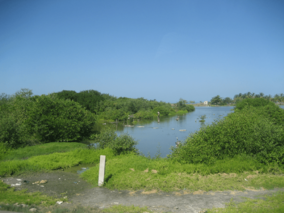Salamanca Island Road Park facts for kids
Quick facts for kids Vía Parque Isla de Salamanca |
|
|---|---|
| Salamanca Island Road Park | |
|
IUCN Category III (Natural Monument)
|
|

Ciénaga Grande de Santa Marta viewed from the road park
|
|
| Nearest city | Ciénaga, Colombia |
| Area | 562 km2 (217 sq mi) |
| Established | 1964 |
| Governing body | SINAP |
The Salamanca Island Road Park (also called Vía Parque Isla de Salamanca in Spanish) is a special national park in Colombia. It's located near the city of Ciénaga in the Magdalena Department, right by the Caribbean Sea. This park is amazing because it's where fresh water from the Magdalena River mixes with salty ocean water. This mix creates a perfect home for lots of different plants and animals. The park was created in 1964 to protect its many birds and coastal mangrove forests.
The name Vía Parque means "Park Road" in Spanish. This is because a main road connecting Santa Marta and Barranquilla goes right through the park. In 2000, UNESCO recognized the park as a Biosphere Reserve, which means it's a globally important place for nature and people to live together.
Contents
Park Weather and Climate
The Salamanca Island Road Park has a very dry climate. The temperature usually stays between 28 and 30 degrees Celsius (about 82-86 degrees Fahrenheit). The amount of rain the park gets each year is quite low. The eastern part receives about 400 millimeters (15.7 inches) of rain, while the western part gets a bit more, around 760 millimeters (30 inches).
Because it's so hot, more water evaporates from the ground and plants than falls as rain. This means the park often has a water shortage, making it a challenging place for some plants and animals to live.
Plants and Animals of the Park
Most of the park is covered by different types of forests. You'll find mangrove forests, tropical dry forests, and forests that grow along rivers, called riparian forests.
Mangrove Forests
Mangrove forests are very important here, covering about a third of the park's area (12,000 hectares or 29,650 acres). These special trees can grow in salty water. The main types of mangroves you'll see are:
- Red mangrove
- Black mangrove
- White mangrove
- Buttonwood
Amazing Wildlife
The park is home to a huge variety of wildlife, and many of these animals are endangered. Even with some environmental challenges, the park still has a high number of different species.
Scientists have found:
- 33 different kinds of mammals
- 98 types of invertebrates (like insects and crabs)
- 9 kinds of amphibians (like frogs and toads)
- 35 types of reptiles (like snakes and lizards)
- More than 140 different fish species
- 199 kinds of birds, including many that migrate, some that live only in this area, and others that live here all the time.
See also
 In Spanish: Vía parque Isla de Salamanca para niños
In Spanish: Vía parque Isla de Salamanca para niños

